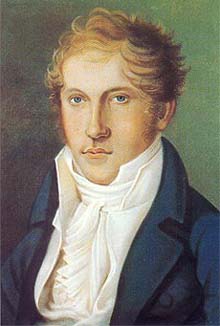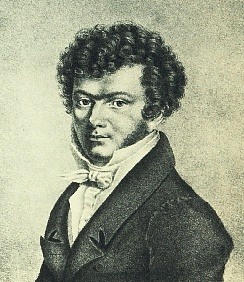Related Research Articles

Carl Philipp Stamitz was a German composer of partial Czech ancestry. He was the most prominent representative of the second generation of the Mannheim School.

Louis Spohr, baptized Ludewig Spohr, later often in the modern German form of the name Ludwig, was a German composer, violinist and conductor. Highly regarded during his lifetime, Spohr composed ten symphonies, ten operas, eighteen violin concerti, four clarinet concerti, four oratorios, and various works for small ensemble, chamber music, and art songs. Spohr invented the violin chinrest and the orchestral rehearsal mark. His output spans the transition between Classical and Romantic music, but fell into obscurity following his death, when his music was rarely heard. The late 20th century saw a revival of interest in his oeuvre, especially in Europe.

Ferdinand Ries was a German composer. Ries was a friend, pupil and secretary of Ludwig van Beethoven. He composed eight symphonies, a violin concerto, nine piano concertos, three operas, and numerous other works, including 26 string quartets. In 1838 he published a collection of reminiscences of his teacher Beethoven, co-written with Franz Wegeler. The symphonies, some chamber works—most of them with piano—his violin concerto and his piano concertos have been recorded, exhibiting a style which, given his connection to Beethoven, lies between the Classical and early Romantic styles.
Felix Mendelssohn's Sextet in D major, Op. 110, MWV Q 16, for piano, violin, two violas, cello, and double bass was composed in April–May 1824, when Mendelssohn was only 15, the same time he was working on a comic opera Die Hochzeit des Camacho. Its composition took place between the Viola Sonata and the Piano Quartet No. 3. It also preceded the famous Octet, Op. 20 by about a year. 1824 is also the probable year of the composition of the Clarinet Sonata. Like the latter, the Sextet was not published during the composer's lifetime. Its first edition was issued in 1868 as a part of a complete collection of Mendelssohn's works. Hence the misleading high opus number.
Ferdinand Ries composed his Cello Sonata in C minor, WoO. 2 in 1799, when he was 17 years old. While the work remained unpublished and does not appear to have been performed in public during the composers lifetime, it is one of the composers earliest surviving compositions, predating his period of study with Beethoven and is the first of four cello sonatas he composed during his life.
Ferdinand Ries composed his Cello Sonata in A major, Op. 21 in 1808, along with the C major, Op. 20 sonata while resident in Paris. However it was not until 1810 that the two works were published by Simrock with dedications to the cellist Bernhard Romberg.
Ferdinand Ries composed his Cello Sonata in C major, Op. 20 in 1808, along with the A major, Op. 21 sonata while resident in Paris. However it was not until 1810 that the two works were published by Simrock with dedications to the cellist Bernhard Romberg.

The Piano Concerto No. 6 in C major, Op. 123, by Ferdinand Ries was composed around 1806. Composed in a proto-Romantic style, similar to the concertos of Johann Nepomuk Hummel, it also shows evidence of the influence of Beethoven's C minor Piano Concerto, Op. 37 which Ries had performed at his public debut in 1804.
The Piano Concerto No. 8 in A-flat major, Op. 151 "Gruss an den Rhein", by Ferdinand Ries was composed around 1826 and published in 1829 by Simrock. While still showing the structural influence of Beethoven's piano concertos, the writing for the piano is more akin to that of later composers such as Chopin, Mendelssohn & Schumann.
The Violin Concerto in E minor, Op. 24 by Ferdinand Ries, was composed around 1810 while the composer was living in Bonn. It appears to have been written for his father, Franz Anton Ries, who gave the first performance of the work at a concert in Bonn on 15 December 1810.
The Trio for Piano, Clarinet and Cello in B-flat major, Op. 28, was composed by Ferdinand Ries in either Bonn in 1809 or Aachen in 1810 during the period he left Vienna to avoid being drafted into the Austrian army. It was published in 1811 by Simrock with a dedication to a Mademoiselle Clairette Ludwigs.

Ferdinand Ries composed his Clarinet Sonata in G minor, Op. 29, in Bonn in 1809 according to his thematic catalog, but it was not published until 1812 by Simrock without a dedication. Its composition history is unclear but it may have been written with a particular clarinetist in mind. The work has sometimes been transcribed for violin.

The Flute Sonata in G major, Op. 87, is a composition for piano and flute by Ferdinand Ries that was published at The Regents Harmonic Institution in London in 1819. Little information about the works composition history is known as the composers manuscript is undated, but Alan Bradly in the preface to the score published by Artaria Editions indicates that the work may have been composed around 1815 along with a number of other works for the same instrumental combination.
Ferdinand Ries's Cello Sonata in G minor, Op. 125 was composed in London in 1823, but was not published until 1825 by T. Boosey & Co. It is one of the final instrumental sonatas published by the composer before his death in 1838.
The Piano Concerto No. 5 in D major, Op. 120 "Concerto Pastorale", by Ferdinand Ries was composed between 1813-1816 and published in 1823 by the firm of Sauer & Leidesdorf with a dedication to Prince Oscar of Sweden.
The Piano Concerto No. 4 in C minor, Op. 115 by Ferdinand Ries was composed in Bonn in 1809 but was not published until 1823 when it was released by both H.A. Probst of Leipzig and Birchall & Cº of London with a dedication to Ignaz Moscheles.
Ferdinand Ries composed his Violin Sonata in A-flat major, WoO. 5 in 1800, when he was 18 years old. There is no evidence the work was performed during the composer's lifetime, and it remained unpublished at his death. The manuscript survives at the Berlin State Library.
Ferdinand Ries composed his Violin Sonata in E-flat major, WoO. 7 in 1804, when he was 22 years old. Surviving in manuscript form in the Berlin State Library, there is no evidence the work was performed during the composer's lifetime and was amongst a number of compositions that remained unpublished at the composers death.
Ferdinand Ries's Violin Sonata in D minor, Op. 83, was composed in Paris in 1808, the same year as the composer's violin sonata Op. 10 and the Op. 20 and Op. 21 cello sonatas. The composition was not published, however, until 1818, after he had moved to London, in a simultaneous edition by both Clementi & Co and Chappell & Co. with a dedication to the "Princess Hatzfeld".
Ferdinand Ries composed the Violin Sonata in B-flat major, Op. 10 in 1808, while he was in Paris. During the same period he also composed his Op. 20 & Op. 21 cello sonatas and a D-minor violin sonata that remained unpublished until 1818. The B-flat major sonata was first published in 1810 by both Breitkopf & Härtel and Simrock with a dedication to a "Monsieur Eichhof, directeur Général de l'Octroi de Navigation du Rhein". Subsequent editions were published in the 1820s.
References
- Notes
- 1 2 3 Hagels 2007 , p. 18
- 1 2 Source for key and tempi: manuscript score at the Berlin State Library.
- ↑ Hill 1977 , p. 203
- Sources
- Hagels, Bert; (Trans.) Prader, Susan Marie (2007). Ferdinand Ries: Double Horn Concerto/Violin Concerto/Two Overtures (CD). cpo. 777 353-2.
- Hill, Cecil (1977). Ferdinand Ries: A Thematic Catalogue. Armidale, NSW: University of New England. ISBN 0-85834-156-5. Archived from the original on 2017-09-25. Retrieved 2017-05-28.
- Hill, Cecil (1982). "Ferdinand Ries. A Study and Addenda". Occasional Paper. Armidale, NSW: University of New England. ISSN 0314-5999. Archived from the original on 2018-02-24. Retrieved 2017-05-28.
- Laursen, Amy D (2015). Determining the Authenticity of the Concerto for Two Horns, WoO. 19, attributed to Ferdinand Ries (PDF) (DMA). University of North Texas. Retrieved 2020-11-11.